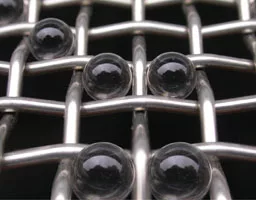Change Your Approach to Establishing Sieve Specifications

At times the image of sieving has been tainted by poor-quality sieves and faulty analysis. There are literally millions of sieves in use around the world, and this technique is still the cheapest way of measuring particle size – by a considerable margin.
Early and continuing attempts to overcome the quality problem have been the purview of standards organizations like ASTM, ISO and other country-specific groups. Part of the issue was because the bulk of the sieves use woven wire mesh to accomplish the screening, a difficult process to maintain precise openings throughout the sieve. Standards were developed to assure consistency in the frame that holds the mesh, to ensure tightness of the mesh when assembled and to fix the acceptable variation of the mesh openings.
Assessment of the suitability of the mesh is delineated by the result of optical/microscope-assisted inspection. The published criteria are stated in terms of average variation in opening size and maximum allowable size of openings inspected. These data are processed to determine the sieve pass or fail status.
Problems with the Process
The process of establishing mesh suitability in a sieve calls for the measurement of a sample of the openings, in a prescribed manner over a delineated geography. The number of openings, selected to reflect a reasonable balance between inspection time and coverage, represents less than .001% of the total sieve openings for a given size. The acceptable variation can exceed 20% of the nominal specified sieve mesh in the lower micron mesh sizes.
When a full certification is performed, a document is prepared that includes the details of all the measurements, averages and deviations. The document states a pass/fail result.
Until the recent ASTM 2009 standards were adopted, there was a single pass/fail criteria. A tighter specification had been proposed by one of the sieve manufacturers. This was known as a mid-point sieve, which was certified to fall in the middle of the published allowable deviations.
The new ASTM standard established three specification levels for the mesh. The inspection results are subject to rigorous statistical analysis and are stated in terms of maximum standard deviation, while retaining the maximum variance averages and maximum individual opening standards. This inspection process, which is referred to as certification, screens out poor-quality mesh.
This certification process does provide a basis for traceability and is insurance from bad-quality sieves. However, it does not give a solid predictor of a sieve’s performance in real-world testing. The small sample of openings inspected and the wide acceptable variation, which increases as the opening size decreases, present a wide framework for performance differences between any two sieves of the same nominal size.
The process of calibration, which is usually done by the users, is all about performance. In this process the performance of a sieve is compared either to the performance of a master sieve or is compared to a prescribed result on a master material. It is at this stage where the sieve performance is established.

|
| Click to enlarge |
New Concept and Approach
As noted, there is a large gap between the nominal size of a sieve and maximum allowable opening. For example, in the latest ASTM standard for a 63 micron sieve, the maximum individual opening can be 89 microns; more than 40% larger. That is significant if the application is for screening out over-sized contaminants or if the specification for the retained amount on the sieve is critical.
More helpful performance-predictive intelligence on a sieve would be the “effective aperture size”. The concept of using calibration spheres has been around for some time, but was not widely used because of precision limitations. Whitehouse Scientific and their managing Director Dr. Graham Rideal took on the task of designing an approach to using glass microspheres to get consistent, effective sieve size information. In over three years of development, the company designed a system to generate microspheres to within +/- 1 micron in smaller sizes.
They also developed a calibration technique for the most popular ranges of sieve sizes, which uses a fixed weight of sample that contains a known distribution of microsphere sizes. This sample is placed on a sieve to be calibrated and shaken for approximately one minute. By measuring the retained weight after this process, the percent of microspheres passing is calculated, which is used to get a mean aperture size from a calibration chart.
Using this method, even a variation of 5% difference in the weight of the passed spheres results in only a 1 micron difference in the aperture size for sieves below 100 microns. Not only does this technique produce an effective performance predictor, but it results in tight accuracy across the range of sieves from 20 microns to 3.35 millimeters.
The calibration process is easy and quick, and can be done on-site; no need to send it out to a laboratory. The process provides a result with traceability to NIST and NPL, needed for most quality-control maintenance systems.
How it Works
To take maximum advantage of what we call the “Calibration Method of Sieve Quality Determination – CMSQD,” it is necessary to change long-standing practices and ideas. Rather than relying on the certification process with attendant data-rich reports, the CMSQD requires only a two-minute process.
The process would start when a new sieve is delivered. A calibration would be done before any testing was performed with the sieve. This calibration results in an “effective mean aperture”. The new sieve now has an operational performance value. Changes in this value will show the effects of usage and provide a basis for determining if the sieve should be replaced.
At the beginning of a program of CMSQD, all functional sieves should be checked and the differences in mean aperture recorded. This establishes a base line for comparing the real-life performance of sieves of the same nominal size but with different mean apertures. Variances between test results of individual sieves can now be related to the mean aperture calibrations, and acceptable aperture limits can be established. The economics of a change to CMSQD should not be more than current costs.
The benefits of moving to a CMSQD include determination of an objective and traceable sieve performance number. This number, mean aperture, for the first time provides a basis for evaluating the performance of a sieve in the working test environment, a benchmark to compare the wear on a sieve and a reference to compare multiple sieves of the same size, all at a cost no more than the traditional certification charges. The calibration process is so simple, little training is required and the time to compete a calibration is measured in minutes, not hours.
Summary
Sieving has lasted as a widely used way of particle size analysis for centuries. In today’s version most sieves are constructed of wire mesh, a tough thing to produce and even tougher to produce with consistent apertures. In the past, these difficulties brought about frequent occasions of bad quality and a tarnished reputation of this Cinderella workhorse. At least as far back as 1985, ASTM established standards for wire mesh sieves, stating acceptable variations in sieve wire openings. A certification that a sieve met the E11 requirements served as an insurance policy against shoddy workmanship.
Users who wanted to get a measure of how a sieve performed (calibrated against something), certified or not, needed to compare it to either a sieve of known performance (master sieve) or to the result obtained using a master sample. These have been the most common methods employed to get a performance measure for sieves used for quality control measurement.
The introduction of the tight tolerance and traceable glass microspheres has provided a new technique for the calibration task. Not only does this method accomplish the comparison task but it brings a spotlight to the expected performance by defining the mean aperture.
The tools are in place to bring about a pervasive change to current processes of sieve certification and calibration. Now in one easy, quick step the cumbersome, time-consuming and costly process of optical inspection, setting up and running master stacks, or preparing master samples can be eliminated
In conclusion, the use of calibrated glass microspheres is the logical way to establish, measure and delineate sieve quality and determine performance criteria and measurements.
For more information, call 703/876.4030 or e-mail agatenby@cscscientific.com.
Looking for a reprint of this article?
From high-res PDFs to custom plaques, order your copy today!




